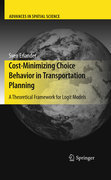
Cost-minimizing choice behavior in transportationplanning: a theoretical framework for logit models
Erlander, Sven B.
This book stems from a desire to understand the underlying assumptions and structure of the choice probability models most often used in transportation planning. The book investigates how far a new way of defining cost minimizing behavior can take us. All commonly used choice probability distributions of the logit type – log linear probability functions – follow from cost minimizing behavior defined in the new way; some new nested models also appear. The new approach provides a deeper understanding of what is at work in the models. The newway of defining cost minimizing behavior is as follows: cost minimizing behavior pertains if the likelihood (probability) of any independent sample of observations is a decreasing function of the average cost of the sample. Extreme value distributed random variables are not used in the derivation of models. A measure of freedom of choice related to the Shannon measure of how much 'choice' is involved is used to obtain a welfare measure which is equal to compositecost. INDICE: 1 Logit Models for Spatial Interaction - Background.- 2 Empirical and Policy Relevance of the New Paradigm.- 3 Behavioral Foundations of SpatialInteraction Models.- Part I: Cost-Minimizing Behavior - Contant Link Costs.- 4 Logit Models for Discrete Choice.- 5 Some Particular Logit Models.- 6 Welfare, Benefit and Freedom of Choice.- 7 Graphical Tests of Cost-Minimizing Behavior in Logit Models.- Part II Equilibrium.- 8 Equilibrium.- 9 Appendix.- References
- ISBN: 978-3-642-11910-1
- Editorial: Springer
- Encuadernacion: Cartoné
- Páginas: 160
- Fecha Publicación: 01/04/2010
- Nº Volúmenes: 1
- Idioma: Inglés
